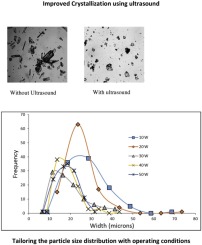Chemical Engineering and Processing: Process Intensification ( IF 3.8 ) Pub Date : 2019-11-28 , DOI: 10.1016/j.cep.2019.107768 Ankit Sharma , Parag R. Gogate

|
Crystallization of Mefanamic acid (MA), a pharmaceutically important drug has been investigated in the presence of ultrasound with an objective of improving the yield and particle size distribution (PSD). The conventional approach based on only stirring has also been compared with the ultrasound assisted approach to establish the improvements due to the use of ultrasound. Effect of various ultrasonic parameters on the crystallization yield, crystal habit, particle size and particle size distribution has been elucidated. For the ultrasound assisted approach, it was demonstrated that plate shaped particles are obtained which are more useful in terms of their bioavailability. The conventional method resulted in needle shaped crystals. Study of different operating conditions established that maximum yield (82.11 %) was obtained under conditions of 40 W as the ultrasonic power and 40 kHz frequency. Use of 22 kHz frequency gave slightly lower yield as 77.17 % at same power dissipation. Higher frequency of 40 kHz also resulted in smaller particle size as compared to 22 kHz frequency. The studies related to effect of irradiation time at the optimized values of frequency and power demonstrated that 10 min of irradiation is optimum in terms of giving higher yield of the crystals. Overall, ultrasound assisted approach was found to be much better than the conventional method and establishing best operating conditions in the study allowed obtaining enhanced yield and uniform shape coupled with reduction in the mean particle diameter.
中文翻译:

使用在两个频率下运行的超声波浴改善了甲芬那酸的结晶
为了改善收率和粒径分布(PSD),已经在超声存在下研究了甲基萘丙酸(MA)的结晶,这是一种药学上重要的药物。还已经将仅基于搅拌的常规方法与超声辅助方法进行了比较,以建立由于使用超声而产生的改进。已经阐明了各种超声参数对结晶产率,晶体习性,粒度和粒度分布的影响。对于超声辅助方法,已证明获得了板状颗粒,其生物利用度方面更有用。常规方法产生针状晶体。对不同运行条件的研究确定了最大产量(82。在超声功率为40 W,频率为40 kHz的条件下获得了11%的电流)。在相同的功耗下,使用22 kHz频率会产生较低的成品率,为77.17%。与22 kHz频率相比,40 kHz的较高频率也导致了较小的粒度。有关在最佳频率和功率值下辐照时间影响的研究表明,辐照10分钟对于提高晶体的产率是最佳的。总体而言,发现超声辅助方法要比传统方法好得多,并且在研究中建立最佳操作条件可以提高产量和形状均匀,同时减小平均粒径。在相同功耗下为17%。与22 kHz频率相比,40 kHz的较高频率也导致了较小的粒度。有关在最佳频率和功率值下辐照时间影响的研究表明,辐照10分钟对于提高晶体的产率是最佳的。总体而言,发现超声辅助方法要比传统方法好得多,并且在研究中建立最佳操作条件可以提高产量和形状均匀,同时减小平均粒径。在相同功耗下为17%。与22 kHz频率相比,40 kHz的较高频率也导致了较小的粒度。有关在最佳频率和功率值下辐照时间影响的研究表明,辐照10分钟对于提高晶体的产率是最佳的。总体而言,发现超声辅助方法要比传统方法好得多,并且在研究中建立最佳操作条件可以提高产量和形状均匀,同时减小平均粒径。有关在最佳频率和功率值下辐照时间影响的研究表明,辐照10分钟对于提高晶体的产率是最佳的。总体而言,发现超声辅助方法要比传统方法好得多,并且在研究中建立最佳操作条件可以提高产量和形状均匀,同时减小平均粒径。有关在最佳频率和功率值下辐照时间影响的研究表明,辐照10分钟对于提高晶体的产率是最佳的。总体而言,发现超声辅助方法要比传统方法好得多,并且在研究中建立最佳操作条件可以提高产量和形状均匀,同时减小平均粒径。











































 京公网安备 11010802027423号
京公网安备 11010802027423号